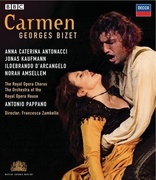
歌剧:比才【卡门】
法国作曲家乔治·比才(Bizet),又名比捷。1838年10月25日出生于巴黎,父亲是声乐教师,母亲出身于音乐世家。九岁学钢琴,同年考入巴黎音乐学院,后又随古诺学习。
歌剧《卡门》 完成于1874年秋,是比才的最后一部歌剧,也是当今世界上上演率最高的一部歌剧。 四幕歌剧 《卡门》主要塑造了一个相貌美丽而性格倔强的吉卜赛姑娘——烟厂女工卡门。卡门使军人班长唐·豪塞堕入情网,并舍弃了他在农村时的情人 —— 温柔而善良的米卡爱拉。后来唐·豪塞因为放走了与女工们打架的卡门而被捕入狱,出狱后他又加入了卡门所在的走私贩的行列。卡门后来又爱上了斗牛士埃斯卡米里奥,在卡门为埃斯卡米里奥斗牛胜利而欢呼时,她却死在了唐·豪塞的剑下。
本剧以女工、农民出身的士兵和群众为主人公, 这一点,在那个时代的歌剧作品中是罕见的、可贵的。也许正因为作者的刻意创新,本剧在初演时并不为观众接受,但随着时间的推移,这部作品的艺术价值逐渐得到人们的认可,此后变得长盛不衰。这部歌剧以合唱见长,剧中各种体裁和风格的合唱共有十多部。
歌剧的序曲为A大调,四二拍子,回旋曲式。整部序曲建立在具有尖锐对比的形象之上,以华丽、紧凑、引人入胜的音乐来表现这部歌剧的主要内容。序曲中集中了歌剧内最主要的一些旋律,而且使用明暗对比的效果将歌剧的内容充分地表现了出来 ,主题选自歌剧最后一幕中斗牛士上场时的音乐。 本剧的序曲是音乐会上经常单独演奏的曲目。
第一幕中换班的士兵到来时,一群孩子在前面模仿着士兵的步伐开路。孩子们在轻快的2/4拍子,d小调上,唱着笛鼓进行曲《我们和士兵在一起》。在这一幕塑造了吉卜赛姑娘卡门热情、奔放、富于魅力的形象。主人公卡门的著名咏叹调《爱情像一只自由的小鸟》是十分深入人心的旋律,行板、d小调转F大调、2/4拍子,充分表现出卡门豪爽、奔放而富有神秘魅力的形象。 卡门被逮捕后,龙骑兵中尉苏尼哈亲自审问她,可她却漫不经心地哼起了一支小调,此曲形象地表现出卡门放荡不羁的性格。还是这一幕中,卡门在引诱唐·豪塞时,又唱出另一个著名的咏叹调,为快板、3/8 拍子,是一首西班牙舞蹈节奏的迷人曲子,旋律热情而又有几分野气 , 进一步刻画了卡门性格中的直率和泼辣。
第一幕与第二幕之间的间奏曲也十分有名, 选自第二幕中 唐·豪塞的咏叹调《阿尔卡拉龙骑兵》,大管以中庸的快板奏出洒脱而富活力的主旋律。
第二幕中还有一段吉普赛风格的音乐, 表现的是两个吉普赛女郎在酒店跳舞时纵情欢乐的场面,跳跃性的节奏和隐约的人声烘托出酒店里喧闹的气氛。
第二幕与第三幕之间的间奏曲是一段轻柔、优美的旋律,长笛与竖琴交相辉映,饱含脉脉的温情。
第三幕中著名的 《斗牛士之歌》,是埃斯卡米里奥为感谢欢迎和崇拜他的民众而唱的一首歌曲。这首节奏有力、声音雄壮的凯旋进行曲,成功地塑造了这位百战百胜的勇敢斗牛士的高大形象。
第四幕的结尾,正象柴科夫斯基所说的那样: “当我看这最后一场时,总是不能止住泪水,一方面是观众看见斗牛士时的狂呼,另一方面却是两个主人公最终死亡的可怕悲剧结尾,这两个人不幸的命运使他们历尽辛酸之后还是走向了不可避免的结局。” 剧中还有一段脍炙人口的西班牙风格舞曲“阿拉贡”, 也是音乐会上经常单独演出的曲目。
Name: Georges Bizet: Carmen
Original title: Bizet: Carmen
Released: 2007
Genre: Opera
Directed by: Francesca Zambello
Conductor: Antonio Pappano
Starring: Anna Caterina Antonacci (Carmen), Jonas Kaufmann (Don Jose), Norah Amsellem (Micaela), Ildebrando D'Arcangelo (Escamillo), Jacques Imbrailo (Morales), Matthew Rose (Matthew Rose), Elena Xanthoudakis (Frasquita), Viktoria Vizin (Mercedes), Caroline Lena Olsson (Lillas Pastia), Jean Sebastien Bou (Le Dancaire), Jean-Paul Fouchecourt (Le Remendado), The Orchestra & Chorus of the Royal Opera House
This Covent Garden production of Bizet's Carmen, makes a vivid musical and dramatic impression. Director Francesca Zambello creates a properly Spanish atmosphere, filling the stage with a profusion of detailed characters. In Act One's town square each of the many soldiers, strollers, cigarette factory girls, and children are individuals, so there's a bustle of continuous, realistic activity. That attention to detail carries over to the rest of the opera, involving viewers in the action. Tanya McCallin's sets are a perfect foil for the direction: simple, movable panels that serve as lightly sketched backdrops for the town square, a tavern, the smugglers' mountain hideaway, and the final scene in front of the bull ring. But what makes this Carmen special is the singing and acting of the principals. Carmen is Anna Caterina Antonacci, a soprano known for the intensity she brings to her performances. Without taking anything to excess, her Carmen is a fiery temptress, sexy, insistent on setting her own terms for love and personal freedom. She sings all the set pieces well and, with tenor Jonas Kaufmann as her besotted lover, Don José, makes the final scene a hair-raising experience. If anything, Kaufmann trumps her with a beautifully sung, rounded portrait of the village boy turned soldier ensnared in a world beyond his experience. Kaufmann conveys the complexity of the character and etches his slow descent into obsessive madness. His rendition of the Flower Song is extraordinary for beauty of tone, phrasing and the soft singing essential to make this aria's full impact. The toreador, Escamilio, is finely sung and acted by Ildebrando D'Arcangelo. He makes his entrance on horseback, sings the Toreador Song with brash arrogance, and projects this haughty, self-absorbed figure to perfection. And Norah Amsellem, as the village girl who loves Don José, uses her attractive soprano to depict her purity and innocence. Smaller roles are well done, with special mention due to bass Matthew Rose as Zuniga, the lieutenant of the guard. The vibrant conducting of Antonio Pappano is a big plus here; pacing is perfect, rhythms vibrantly precise, and melodies shaped with care. Under his baton, the Royal Opera House chorus and orchestra complete a rich, well-detailed performance of Bizet's masterpiece. Lighting designs of Paule Constable add to the atmosphere of each scene, while television director Jonathan Haswell's cameras always seem to be where they should be.
Issued: United States | Decca Music Group
Length: 2:32:04
 淘宝店铺:http://94hd.taobao.com
淘宝店铺:http://94hd.taobao.com